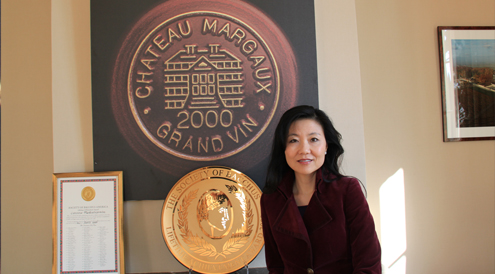Pontallier compares it to the 1990 vintage for Chateau Margaux, with the same type of polished tannins but he concludes, 2009 has much greater concentration. He adds, “For me, the 2009 is even better than the 2005. This vintage has incredible concentration and higher tannin levels but a softer texture. The 2005 had tougher tannins.” The Pavillon Rouge (Margaux’ second wine) is a joy to taste – seamless and elegant but with plenty of lifted fruit and firm tannins.
As with most top chateaux, the Grand Vin (the grand wine or the first wine) is composed of the top 36% of the crop under strict selection. The rest of the wine is divided up into Pavillon Rouge (the 2 nd wine) and the rest is declassified. This year in 2009, only 40% of the remaining portion made it into the Pavillon Rouge. If the quality of the grapes was so high, why was nearly a quarter of the crop declassified? Pontallier says it is because they had the possibility to make the best Pavillon and they chose to do this by severe selection and decreasing volume. The result is a concentrated Pavillon Rouge that will likely be good value (if historical prices are anything to go by).
The white wine of Chateau Margaux is produced in much smaller volumes than their reds and generally is not well known in Asia. The quality is superb in most vintages and worth seeking out. This year, there is a lightness in the Pavillon Blanc which is noticeable – there is a move away from heaviness and towards more precisely defined fruit. Pontallier explained that the team felt the whites were too high in alcohol and it was a concern because it affected the overall balance and style of the wine. To bring down the alcohol which was creeping towards 15%, harvesting and pressing procedures were reviewed. In 2009, harvest was slightly earlier than normal and less pressings were used resulting in a white wine that is about 1 alcoholic degree lower than in previous years. The 2009 is 13.9% alcohol but feels even lower because the fresh acidity and the purity of fruit.
The wines of Chateau Margaux represent the epitome of elegance. The wines, both the reds and the white possess an ethereal lightness and the power which is present and very much in the background; on the palate this is expressed in the flavours which resonates long after the wine has left the tongue. To ensure that this elegant style is appreciated in Asia, Pontallier’s son, Thibault Pontallier will be resident and based in Hong Kong for a minimum of two years as Chateau Margaux’ Asian representative. This is a pioneering step for a first growth chateau and a move that most likely many others may follow.










